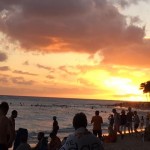
The Hawaiian Islands were created by a chain of volcanic hot spots in the Pacific and long settled by voyageurs who travelled thousands of miles across open water. The interrelationship and adaptation of nature and culture on these islands by early settlement and more recently by the arrival of Europeans and others starting in 1778 present lessons for the future of conservation. So it was fitting that the International Union for the Conservation of Nature (IUCN) held its first ever World Conservation Congress in the United States in Hawai’i. For ten days in September (1-10, 2016) more than 10,000 conservationist leaders from at least 193 countries gathered to advance conservation thinking and strategies around the theme of “Planet at a Crossroads”. The need to approach conservation at the landscape scale was implicit or explicit in most of the presentations and the importance of looking at nature and cultural in a holistic manner was highlighted at the congress by a track (called a journey) dedicated just to the topic.
IUCN and ICOMOS (International Council on Monuments and Sites – the cultural heritage counterpart to IUCN) co-sponsored the Nature-Culture Journey and a companion World Heritage Journey at the conference. This special track helped bring together a diverse community of international conservationists who are members of indigenous community groups, working with World Heritage Sites, large landscape practioners, and representing the traditional ecological knowledge of working landscapes and seascapes. Featuring over 50 related sessions, the journey examined the growing evidence that natural and cultural heritage are closely interconnected in many landscapes/seascapes and the need to better integrate both disciples for effective conservation outcomes. Both natural and cultural heritage experts face similar conservation challenges in places with complex interrelated ecological and cultural networks – often across large landscapes – and each brings a body of complementary knowledge and capacities.
The connections and insights gained during the journey underscored the need to work more closely together to advance good conservation practice. This dialogue produced a statement of commitments, Mālama Honua: to care for our island Earth that was signed by the Nature Culture Journey attendees at the Journey’s closing reception. This statement (currently being translated into French and Spanish) will soon be on-line and available for additional signatures. Follow up discussions are being planned for the 2017 ICOMOS General Assembly in Delhi, India. Based on the promising work in Hawai’i, strengthening the connections around a shared interest in nature and culture conservation is an idea that is now on the horizon.
Many thanks to Nora Mitchell one of the lead planners of the Nature Culture Journey for her contribution to this article.


